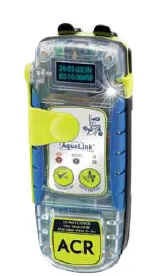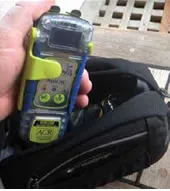
Photo courtesy of ACR Electronics
149
Back when personal locator beacons (PLBs) first rolled out, we were giddy at the thought that we had technology, literally in the palm of our hands, that allowed us to signal for help worldwide. Those early PLBs did what we asked of them, and all we asked was that they let us send out a call for help in an emergency. My, how times have changed.
In today’s world of increasing “smart” technology, PLBs have stepped up their game. Not only do some show your position via digital displays, many also allow you to conduct live self-tests through the COSPAS-SARSAT satellite system (the one used by international search-and-rescue organizations) and verify operation before you even leave the dock.
However, the biggest change in today’s PLB is the ability to use it as a global, satellite-based non-emergency communicator to send messages and position data to yourself, friends and family via e-mail or cell phone. In effect, the rising popularity of new satellite emergency notification devices (SENDs) like the SPOT (see PS, August 2012) have prompted PLB manufacturers to incorporate these non-emergency features into what is principally an emergency signaling device.
While it is good that manufacturers have found ways to increase the self-test functionality of PLBs, as well as offer another means of closing the communication gap between the boat and people ashore, PS was concerned that these “extras” would come at the expense of the PLB’s primary purpose. Would the repeated use of one of these emergency devices for non-emergency functions deplete the battery to a point that would inhibit its function in an emergency?
We decided to run one of the newer PLBs through its paces to see just how non-emergency use affected battery life or any other functions that would be required in an emergency.
What We Tested
Our test unit was an AquaLink View 406 MHz GPS (model PLB-350C) manufactured by Fort Lauderdale, Fla.-based ACR Electronics and retailing for about $450. Founded in 1956, ACR was recently sold by its parent company, Cobham, to the investment group J.F. Lehman and Co.
Since the introduction of the AquaLink View 406 in 2009, ACR has launched two smaller, pocket-sized PLBs—the ResQLink (about $280) and the ResQLink+ (about $300). All of these PLBs are powered by non-rechargeable lithium batteries that must be replaced at five-year intervals at a cost of about $150 per replacement. (The service includes the battery, new gaskets and hardware, and pressure testing to ensure the device is waterproof.)
Apart from the size, the main difference between the AquaLink View and the ResQLink is the AquaLink View’s digital readout confirming self-tests and displaying GPS position.
For the purposes of our test, we also set up an account with 406Link.com, ACR’s Internet-based service that enables added PLB self-test and messaging features for a fee. The 406Link basic service ($40 per year) allows users to carry out advanced testing of their ACR PLBs via the COSPAS-SARSAT system. The 406Link Plus ($60 per year) service provides both the self-test feature and the ability to send canned or customizable test results using short message service (SMS) and email messages, and with GPS-enabled PLBs, you can send a hyperlink map of your location to a maximum of five contacts.
The ability to carry out advanced self-testing via the COSPAS-SARSAT satellite network is one of the most useful features of the new generation of PLBs. Self-test modes on older EPIRBs and PLBs give limited indication that the signal is reaching the COSPAS-SARSAT satellite, and no way to confirm the unit’s internal GPS receiver was working.
The AquaLink and ResQLink PLBs provide two types of self-test. The first is a basic self-test mode, which is required in all PLBs. This test checks the data integrity and memory, the 406-MHz synthesizer, transmit power, battery status, and the GPS header. ACR recommends that this test be carried out once a month and before going to sea. Subscribers to the 406Link basic service will also receive a confirmation to their email inbox or phone indicating that a basic test was successful.
In the advanced, GNSS self-test mode, the AquaLink’s digital display shows your position and visual confirmation that COSPAS-SARSAT satellites are receiving your GPS position. Subscribers to the 406Link service also receive short email or text messages to their phone verifying the test.
To preserve battery life, the number of self-tests and messages a user can send over the life of their PLB battery is limited according to the type and age of the unit. For the new, out-of-the-box Model 350C provided to us, ACR advertises a maximum of 420 basic test messages (without using GPS) and up to 60 GNSS tests. Internal sensors monitor battery status, and as the unit ages, this messaging fixed capacity is automatically reduced. Once you max out the 60 GNSS self-tests, you can still perform the basic self test, but the GPS test function is automatically disabled to prevent excessive use and battery drain.
According to the standards set by the Radio Technical Commission for Maritime Services (RTCM), a PLB must be able to transmit for at least 24 hours throughout the device’s specified temperature operating range. The tests used to determine whether a PLB meets this specification are carried out using new batteries. The testers then factor in the rates of depletion for the lithium battery cells over their lifetime and account for the power required for the additional functions (text messaging, advanced self-tests, etc.), to determine whether enough battery power is available to meet the 24-hour transmit requirement.
How we tested
We took a different approach to evaluating battery life. For our test, we took a PLB that had been “messaged-to-the-max,” so to speak, and then checked to see whether it still had enough juice to meet the 24-hour transmit requirement.
Over the course of one week, our tester limbered up his button-pushing finger and conducted 60 GNSS (GPS) self-tests—a function that automatically disabled after 60 such tests, as advertised—and 283 basic self-tests. We also sent ourselves 40 pre-canned SMS messages. Once these tests were completed, the unit was left dormant for eight months, after which we sent it to Imanna Laboratory Inc. in Rockledge, Fla., to determine the remaining battery life under continuous use.
At Imanna, the PLB was placed in a radio-frequency screen room (to prevent alert of the COSPAS-SARSAT system), activated, then monitored with a spectrum analyzer until battery discharge reached a point where acceptable radio-frequency output had ceased. Since the PLB was located in a screen room where no satellites were visible, the GPS receiver activated but did not provide position data, a scenario that draws the maximum GPS receiver current from the battery. The LED strobe produced a visible flash throughout the test.
Once activated, PLBs produce a periodic radio-frequency burst that sends out a distress signal on the 406-MHz frequency monitored by COSPAS-SARSAT satellites. ACR transmit power is nominally specified at 6.3 watts. (The standard requires 5 watts.) Test data from Imanna states that for 52 hours, our test unit’s signal strength clearly met the international standard—greater than 125 decibels above one microvolt (dBμV) when using Imanna’s test protocol. According to Imanna’s data, the radio-frequency output during the 52 hours held at about 127 dBμV.

Photo by Frank Lanier
170
Analyzing the results
Once all of Imanna’s numbers were crunched—decibels above 1 microvolt (dBμV) are converted to decibels above 1 milliwatt (dBm), the antenna gain is subtracted, and signal path loss is added—the test results translate to an output of 38.7 dBm for 52 hours. This is at the top end of the COSPAS-SARSAT minimum specification for PLBs, which is 37 dBm +/- 2dB.
ACR’s engineers cautioned that the 52-hour battery life did not mean we could expect two days of distress signals from our PLB. They noted that our test was done at ambient temperature of about 70 degrees, which will produce a much longer battery life than if it was tested at -4 degrees (-20 Celsius), which is what COSPAS-SARSAT requires. They pointed out, however, that even when one compensated for temperature, the battery life still would have well exceeded the 24-hour requirement.
“One point to remember is that the battery has to be capable of meeting specification at the end of five years, plus a safety factor, and that this is built into the COSPAS-SARSAT and RTCM test regimes,” explained ACR’s Mikele D’Arcangelo. “Had those allowances also been made, the battery life still would have been way over the required 24 hours.”
Conclusion
Battery life is at the heart of any satellite distress-signaling device. We were happy to see that the PLB we tested continued to meet the specifications for distress signaling even after we’d exhausted its advanced self-test functions and sent dozens of messages. Two advantages of having non-rechargeable lithium batteries built into a PLB are that the watertight integrity of the unit is preserved and battery life is generally more consistent and reliable. The big drawback is the hefty price tag that PLB and EPIRB makers charge for replacement batteries—something to consider when you compare products.
PLBs remain our first choice for a backup to an EPIRB for offshore boats, and the added messaging capability through services like 406Link adds versatility. Use these functions sparingly. ACR presents the SMS functions as “tests” to federal agencies, but some retailers’ sales pitches highlight the device’s SPOT-like “I’m OK” messages for non-emergency use. To be clear, a PLB is not a SEND, which generally carries out these non-emergency functions much better; but stringent international standards for PLBs and built-in safeguards against “user errors” give PLBs an important advantage for emergency use.
Perhaps the most critical lesson from our exercise was the importance of being familiar with the self-test functions of your PLB and EPIRB—some types like our AquaLink 350C emit complicated LED light flashes that require a code to interpret—and of routinely carrying out the self-test functions of your PLB and EPIRBs, especially prior to a voyage.


































